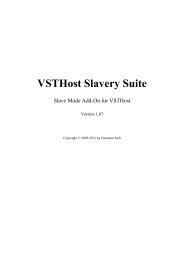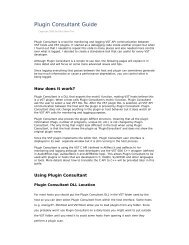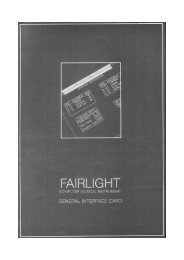VSTHost - Hermann Seibs Hauptseite
VSTHost - Hermann Seibs Hauptseite
VSTHost - Hermann Seibs Hauptseite
Create successful ePaper yourself
Turn your PDF publications into a flip-book with our unique Google optimized e-Paper software.
This is one of the more complex windows in <strong>VSTHost</strong>, since there are quite a lot of possibilities.<br />
Nearly all of the fields here are spin controls; i.e., they got a spin button on their right side that allows<br />
scrolling through the possible values by clicking in on the upper/lower half. Dragging the mouse up or<br />
down allows to change the speed at which the selection changes. Wherever possible, clicking the item<br />
with the right mouse button offers a context menu with all possible settings. Some of the fields can be<br />
edited directly by double-clicking them.<br />
As soon as you change the value of the last line’s MIDI Type from *None* to anything else, a new<br />
*None* line is added to the list. This allows the definition of as many lines as you like. All lines<br />
containing a type of *Learn* or *None* are discarded when the window is closed with OK.<br />
The window has two parts; the left part defines the incoming MIDI message(s), the right part defines<br />
which parameter is to be modified by them, and how. The two parts are discussed below.<br />
There are some additional buttons on the window. Reset simply resets the list. Load… can be used to<br />
load a new mapping from a file, whereas Save… can be used to save the current mapping to a file.<br />
Attention: <strong>VSTHost</strong> does not check the PlugIn type when loading a mapping from a file; since only<br />
the Parameter number is saved, mappings created for a completely different PlugIn will be happily<br />
loaded, but may result in undesirable mappings, since each PlugIn has its own idea about which<br />
parameter is at which position.<br />
Incoming MIDI Message<br />
This side defines the incoming MIDI message to be mapped to a parameter. It consists of the<br />
following fields:<br />
Type This field defines the type of the MIDI message(s) processed for this line. Aiming<br />
to be as versatile as possible, there are quite a lot of choices here:<br />
*Learn* If this type is selected, <strong>VSTHost</strong> uses the next<br />
incoming MIDI message to define the type of the<br />
MIDI message.<br />
*None* This is the default value; lines of this type are ignored<br />
by MIDI processing.<br />
Bank React on an incoming CC#0 (and eventually CC#32)<br />
message. This can be either a 7-bit or 14-bit message.<br />
Program React on an incoming Program Change message.<br />
CC React on an incoming Continuous Controller<br />
message. If the controller number is below 32, this<br />
can be either a 7-bit or 14-bit controller.<br />
RPN React on an incoming RPN message bundle. Both<br />
Increment/Decrement and Data Entry are processed.<br />
NRPN React on an incoming NRPN message bundle. Both<br />
Increment/Decrement and Data Entry are processed.<br />
Pitch React on an incoming Pitch Wheel message<br />
Note On Key React on an incoming Note On message’s key. # in<br />
this case defines the velocity.<br />
Note On Velocity React on an incoming Note On message’s velocity. #<br />
in this case defines the key.<br />
Note Off Key React on an incoming Note Off message’s key. # in<br />
this case defines the velocity.<br />
Note Off Velocity React on an incoming Note Off message’s velocity. #<br />
in this case defines the key.<br />
Poly Aftertouch Key React on an incoming Polyphonic Aftertouch<br />
message’s key. Not many attached keyboards will be<br />
able to deliver this. # in this case defines the pressure.<br />
Channel Pressure React on an incoming Channel Pressure message.<br />
Clock This, actually, isn’t a MIDI message; <strong>VSTHost</strong> can<br />
44





